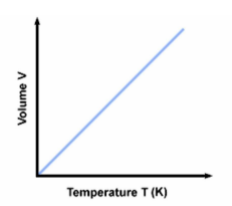
According to Charles law \[V=KT\] where k is constant. The unit of K is:
A. \[{{m}^{3}}{{K}^{-1}}\]
B. \[{{m}^{-3}}{{K}^{1}}\]
C. \[{{m}^{3}}{{K}^{2}}\]
D. \[{{m}^{-3}}{{K}^{-2}}\]
Answer
567.6k+ views
Hint: The unit of volume is metre cube. Unit of temperature is Kelvin as measured in standard units (S.I). Now from the relation \[V=KT\], \[K=V\div T\].
Therefore the unit of the constant K is \[{{m}^{3}}{{K}^{-1}}\].
Complete step by step solution:
According to Charles law temperature and pressure remaining constant volume of a gas is directly proportional to the absolute temperature.
Therefore from Charles law,
\[V1\div T1=V2\div T2\].

V1 is first volume, V2 second volume T1 is first temperature and T2 is second temperature.
A standard unit of measurement is a quantifiable language that helps everyone understand the association of objects with measurement. It is expressed or defined in inches, feet, and pounds, in the United States, and centimeters, meters, and kilograms in the metric system.
Measurement of any physical quantity involves its comparison with a certain basic, reference standard called unit.
\[Measurement=nu\] Here,n is numerical value and u is unit.The numerical value is inversely proportional to the size of the unit.
\[n*u=constant\] So , n is inversely proportional to u.
Now let's introduce you to the dimensions of a physical quantity
There are 7 dimensions of a physical quantity as mentioned in the world:
Dimension of length=L
Dimension of mass = M
Dimension of time = T
Dimension of electric current = A
Dimension of thermodynamic temperature = K
Dimension of luminous intensity = cd
Dimension of amount of substance = mol
Note: The SI unit of mass, length and time are kilogram , metre and second and the corresponding CGS units are gram, centimetre and second.
Therefore the unit of the constant K is \[{{m}^{3}}{{K}^{-1}}\].
Complete step by step solution:
According to Charles law temperature and pressure remaining constant volume of a gas is directly proportional to the absolute temperature.
Therefore from Charles law,
\[V1\div T1=V2\div T2\].

V1 is first volume, V2 second volume T1 is first temperature and T2 is second temperature.
A standard unit of measurement is a quantifiable language that helps everyone understand the association of objects with measurement. It is expressed or defined in inches, feet, and pounds, in the United States, and centimeters, meters, and kilograms in the metric system.
Measurement of any physical quantity involves its comparison with a certain basic, reference standard called unit.
\[Measurement=nu\] Here,n is numerical value and u is unit.The numerical value is inversely proportional to the size of the unit.
\[n*u=constant\] So , n is inversely proportional to u.
Now let's introduce you to the dimensions of a physical quantity
There are 7 dimensions of a physical quantity as mentioned in the world:
Dimension of length=L
Dimension of mass = M
Dimension of time = T
Dimension of electric current = A
Dimension of thermodynamic temperature = K
Dimension of luminous intensity = cd
Dimension of amount of substance = mol
Note: The SI unit of mass, length and time are kilogram , metre and second and the corresponding CGS units are gram, centimetre and second.
Recently Updated Pages
Why are manures considered better than fertilizers class 11 biology CBSE

Find the coordinates of the midpoint of the line segment class 11 maths CBSE

Distinguish between static friction limiting friction class 11 physics CBSE

The Chairman of the constituent Assembly was A Jawaharlal class 11 social science CBSE

The first National Commission on Labour NCL submitted class 11 social science CBSE

Number of all subshell of n + l 7 is A 4 B 5 C 6 D class 11 chemistry CBSE

Trending doubts
Differentiate between an exothermic and an endothermic class 11 chemistry CBSE

10 examples of friction in our daily life

One Metric ton is equal to kg A 10000 B 1000 C 100 class 11 physics CBSE

Difference Between Prokaryotic Cells and Eukaryotic Cells

1 Quintal is equal to a 110 kg b 10 kg c 100kg d 1000 class 11 physics CBSE

State the laws of reflection of light




